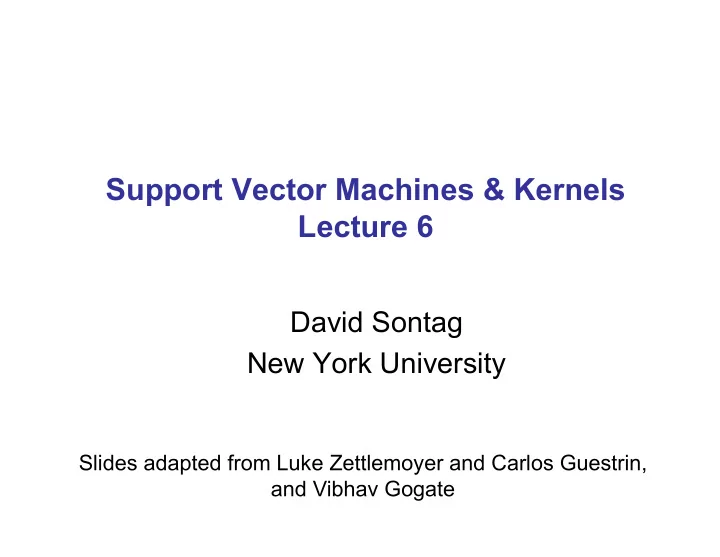

Support Vector Machines & Kernels Lecture 6 David Sontag New York University Slides adapted from Luke Zettlemoyer and Carlos Guestrin, and Vibhav Gogate
Dual SVM derivation (1) – the linearly separable case Original optimization problem: One Lagrange multiplier Rewrite per example constraints Lagrangian: Our goal now is to solve:
Dual SVM derivation (2) – the linearly separable case (Primal) Swap min and max (Dual) Slater’s condition from convex optimization guarantees that these two optimization problems are equivalent!
Dual SVM derivation (3) – the linearly separable case (Dual) ⇤ ⌅ Can solve for optimal w , b as function of α : ∂ L ⌥ ∂ w = w − α j y j x j j Substituting these values back in (and simplifying), we obtain: (Dual) Sums over all training examples scalars dot product
Dual SVM derivation (3) – the linearly separable case (Dual) ⇤ ⌅ Can solve for optimal w , b as function of α : ∂ L ⌥ ∂ w = w − α j y j x j j Substituting these values back in (and simplifying), we obtain: (Dual) So, in dual formulation we will solve for α directly! • w and b are computed from α (if needed)
Dual SVM derivation (3) – the linearly separable case Lagrangian: α j > 0 for some j implies constraint is tight. We use this to obtain b : (1) (2) (3)
Classification rule using dual solution Using dual solution dot product of feature vectors of new example with support vectors
Dual for the non-separable case Primal: Solve for w,b, α : Dual: What changed? • Added upper bound of C on α i ! • Intuitive explanation: • Without slack, α i ∞ when constraints are violated (points misclassified) • Upper bound of C limits the α i , so misclassifications are allowed
Support vectors • Complementary slackness conditions: • Support vectors : points x j such that (includes all j such that , but also additional points where ) ↵ ∗ j = 0 ∧ y j ( ~ w ∗ · ~ x j + b ) ≤ 1 • Note: the SVM dual solution may not be unique!
Dual SVM interpretation: Sparsity w . x + b = +1 w . x + b = 0 w . x + b = -1 Final solution tends to be sparse • α j =0 for most j • don’t need to store these points to compute w or make predictions Non-support Vectors: • α j =0 Support Vectors: • moving them will not • α j ≥ 0 change w
SVM with kernels • Never compute features explicitly!!! – Compute dot products in closed form Predict with: • O(n 2 ) time in size of dataset to compute objective – much work on speeding up
Quadratic kernel [Tommi Jaakkola]
Quadratic kernel Feature mapping given by: [Cynthia Rudin]
Common kernels • Polynomials of degree exactly d • Polynomials of degree up to d • Gaussian kernels Euclidean distance, squared • And many others: very active area of research! (e.g., structured kernels that use dynamic programming to evaluate, string kernels, …)
Gaussian kernel Level sets, i.e. w.x=r for some r Support vectors [Cynthia Rudin] [mblondel.org]
Kernel algebra Q: How would you prove that the “Gaussian kernel” is a valid kernel? A: Expand the Euclidean norm as follows: To see that this is a kernel, use the Taylor series expansion of the Then, apply (e) from above exponential, together with repeated application of (a), (b), and (c): The feature mapping is infinite dimensional! [Justin Domke]
Overfitting? • Huge feature space with kernels: should we worry about overfitting? – SVM objective seeks a solution with large margin • Theory says that large margin leads to good generalization (we will see this in a couple of lectures) – But everything overfits sometimes!!! – Can control by: • Setting C • Choosing a better Kernel • Varying parameters of the Kernel (width of Gaussian, etc.)
Recommend
More recommend